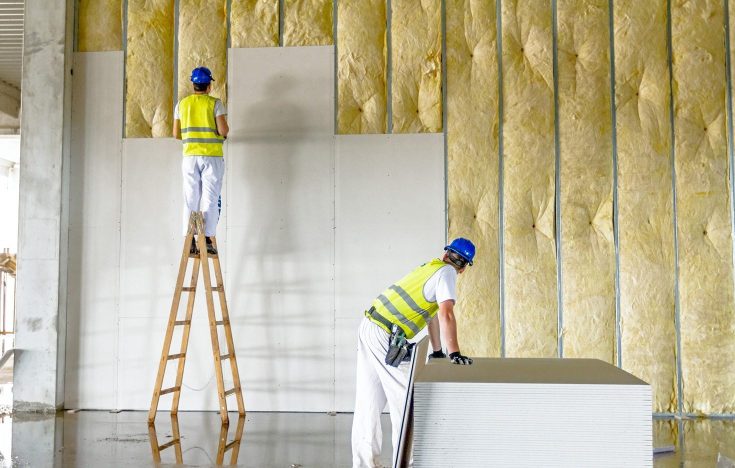Ant leads China tech towards a more sustainable future
China’s Ant Group, a leading technology provider, is the first in the country’s internet sector to secure a sustainability-linked loan.
Worldwide leader in light and sustainable construction, Saint-Gobain has turned to a sustainability-linked loan to support its green ambitions in China.

As part of its commitment to reach carbon neutrality across its operations by 2050, Saint-Gobain has entered into a sustainability-linked loan to finance a new production facility that will support China’s transition to low-carbon construction.
Saint-Gobain is investing in a new plant in Yuzhou, Henan Province, that will use recycled material to produce synthetic gypsum, the base material for plaster and plasterboard. Coal-fired power stations produce a by-product known as de-sulphur gypsum, or DSG, which is then collected and reused in the construction industry, avoiding the need to mine more naturally occurring gypsum from rock.
Saint-Gobain will also use renewable energy to power the Yuzhou plant, further reducing its carbon footprint and producing green building materials for the Chinese market.
To support Saint-Gobain’s capital expenditure on this project, BNP Paribas has provided a bilateral sustainability-linked five-year loan, the first financing of its kind for Saint-Gobain in China.
The credit facility is linked to key performance indicators (KPIs) at the new gypsum plant. The KPIs cover the percentage of green power the new plant will use, the carbon intensity per unit of product, and the use of recycled materials. During the tenor of the loan, the interest rate will be adjusted in line with the company’s ongoing performance against these targets.

The cooperation with BNP Paribas successfully provided us with a new way of moving forward the ESG agenda in China’s growing construction industry and will certainly open up more green cooperation opportunities in the future.
Sheng Zhaoning, CEO, Saint-Gobain China
“Saint-Gobain is dedicated to Making The World A Better Home through relentless product innovation and collaboration with stakeholders involved in the ecosystem,” said Sheng Zhaoning, CEO of Saint-Gobain China. “The cooperation with BNP Paribas successfully provided us with a new way of moving forward the ESG agenda in China’s growing construction industry and will certainly open up more green cooperation opportunities in the future.”

As we strive to accelerate the world’s sustainability transformation, we look forward to further contributing to Saint-Gobain’s sustainability objectives and deepening our green cooperation on a global level.
Bruno Weill, Chief Group Representative for China, BNP Paribas
“We are delighted to support Saint-Gobain’s green and energy saving ambitions in China,” said Bruno Weill, Chief Group Representative for China of BNP Paribas. “As we strive to accelerate the world’s sustainability transformation, we look forward to further contributing to Saint-Gobain’s sustainability objectives and deepening our green cooperation on a global level.”
Like most carbon-intensive industries, the global construction sector is responding to the urgent need to reduce carbon emissions. According to consultancy McKinsey, the construction sector is responsible for 37% of global energy-related CO2 emissions, making it a key contributor to climate change.
Since it committed in 2019 to reaching carbon neutrality across its operations by 2050, Saint-Gobain has reduced its CO2 emissions by 14.5% between 2010 and 2019 – on the way to its target of a 20% reduction in emissions by 2025. This commitment to decarbonisation is reflected in its operations in China, where Saint-Gobain operates over 50 production plants and employs over 8,000 people.
For Saint-Gobain, the financing deepens its commitment to sustainable practices across its operations. The group is investing in light and sustainable materials that are less resource-intensive to make and have the potential to cut the construction sector’s carbon emissions by two-thirds. The products it sells in one year will avoid 1,300 million tonnes of CO2 emissions over their lifespan, and some 72% of group sales provide sustainability benefits either to the planet or to people.
The financing is also in line with BNP Paribas’ own ESG objectives. As part of the group’s 2025 strategic plan, it has pledged to dedicate at least €200 billion to supporting corporate clients’ transition to a low-carbon economy by 2025. In addition, it has earmarked more than €350 billion in loans and bond issues covering environmental and social topics for corporate clients.

We are delighted to have helped Saint-Gobain finalise this SLL to advance their sustainability ambitions in China where it has a significant presence.
Shilpa Gulrajani, Head of Corporate Development and Sustainability, Global Banking APAC, BNP Paribas
“For multinational corporations like Saint-Gobain, global collaboration and understanding of the domestic requirements is key in driving and achieving the company’s ESG goals,” said Shilpa Gulrajani, Head of Corporate Development and Sustainability, Global Banking at BNP Paribas APAC. “We are delighted to have helped Saint-Gobain finalise this SLL to advance their sustainability ambitions in China where it has a significant presence.”
China’s Ant Group, a leading technology provider, is the first in the country’s internet sector to secure a sustainability-linked loan.